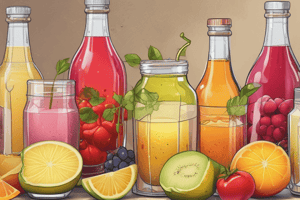Podcast
Questions and Answers
What percentage of fruit juice or pulp is required in squash beverages?
What percentage of fruit juice or pulp is required in squash beverages?
Which of the following beverages is not diluted before serving?
Which of the following beverages is not diluted before serving?
Which preservative is mainly used in the preparation of squash from certain fruits like lemon and papaya?
Which preservative is mainly used in the preparation of squash from certain fruits like lemon and papaya?
What is the minimum total soluble solids requirement for nectar beverages?
What is the minimum total soluble solids requirement for nectar beverages?
Signup and view all the answers
Which fruit is commonly used for making cordial?
Which fruit is commonly used for making cordial?
Signup and view all the answers
What is the maximum allowable sulphur dioxide content in cordial beverages?
What is the maximum allowable sulphur dioxide content in cordial beverages?
Signup and view all the answers
Which of the following beverages contains at least 10% fruit juice and is identified by requiring no dilution?
Which of the following beverages contains at least 10% fruit juice and is identified by requiring no dilution?
Signup and view all the answers
In unfermented beverages, which of the following is categorized under natural juices?
In unfermented beverages, which of the following is categorized under natural juices?
Signup and view all the answers
Study Notes
Fruit Beverages Overview
- Fruit beverages are digestible, refreshing, and nutritionally superior to synthetic drinks.
- Classified into two categories: unfermented and fermented.
Unfermented Beverages
- Defined as fruit juices that do not undergo alcoholic fermentation.
- Examples include natural juices, sweetened juices, Ready-To-Serve (RTS), nectar, cordial, squash, crush, syrup, concentrate, and powder.
- Barley waters and carbonated beverages are also considered unfermented.
Squash
- Contains at least 25% fruit juice or pulp and 40-50% total soluble solids.
- Comprises around 1.0% acid with preservatives like 350 ppm sulphur dioxide or 600 ppm sodium benzoate.
- Diluted before serving; commonly made from mango, orange, and pineapple.
- Can also use lemon, bael, papaya, among others, with potassium metabisulphite as a preservative.
- Other fruits such as jamun, passion-fruit, and various berries can be incorporated using sodium benzoate.
Ready-To-Serve (RTS)
- Contains at least 10% fruit juice and 10% total soluble solids, along with 0.3% acid.
- Not diluted before serving, making it convenient and ready for consumption.
Cordial
- Sparkling, clear beverage that’s sweetened and has all pulp removed.
- Composed of at least 25% fruit juice and 30% total soluble solids.
- Contains around 1.5% acid and 350 ppm of sulphur dioxide.
- Ideal for blending with wines; lime and lemon are commonly used.
Nectar
- Contains a minimum of 20% fruit juice or pulp and 15% total soluble solids.
- Maintains approximately 0.3% acid.
- Not diluted before serving, ensuring a robust flavor profile.
- Specific fruits for nectar production include mango, papaya, and guava, each requiring a certain amount of water for processing.
Studying That Suits You
Use AI to generate personalized quizzes and flashcards to suit your learning preferences.
Related Documents
Description
Explore the world of fruit beverages, focusing on their classification into fermented and unfermented varieties. This quiz will help you understand the nutritional advantages of fruit drinks over synthetic alternatives. Discover what defines unfermented beverages like juices and concentrates.




